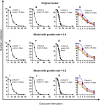Modeling of Experimental Data Supports HIV Reactivation from Latency after Treatment Interruption on Average Once Every 5-8 Days
- PMID: 27560972
- PMCID: PMC4999223
- DOI: 10.1371/journal.ppat.1005740
Modeling of Experimental Data Supports HIV Reactivation from Latency after Treatment Interruption on Average Once Every 5-8 Days
Conflict of interest statement
The authors have declared that no competing interests exist.
Figures


Comment on
-
Insufficient Evidence for Rare Activation of Latent HIV in the Absence of Reservoir-Reducing Interventions.PLoS Pathog. 2016 Aug 25;12(8):e1005679. doi: 10.1371/journal.ppat.1005679. eCollection 2016 Aug. PLoS Pathog. 2016. PMID: 27560936 Free PMC article. No abstract available.
Similar articles
-
Relationship between Measures of HIV Reactivation and Decline of the Latent Reservoir under Latency-Reversing Agents.J Virol. 2017 Apr 13;91(9):e02092-16. doi: 10.1128/JVI.02092-16. Print 2017 May 1. J Virol. 2017. PMID: 28202759 Free PMC article.
-
Molecular mechanisms involved in HIV-1 transcriptional latency and reactivation: implications for the development of therapeutic strategies.Bull Mem Acad R Med Belg. 2004;159(Pt 2):176-89. Bull Mem Acad R Med Belg. 2004. PMID: 15615091 Review.
-
In vitro effects of the small-molecule protein kinase C agonists on HIV latency reactivation.Sci Rep. 2016 Dec 12;6:39032. doi: 10.1038/srep39032. Sci Rep. 2016. PMID: 27941949 Free PMC article.
-
Long-Term Spontaneous Control of HIV-1 Is Related to Low Frequency of Infected Cells and Inefficient Viral Reactivation.J Virol. 2016 Jun 10;90(13):6148-6158. doi: 10.1128/JVI.00419-16. Print 2016 Jul 1. J Virol. 2016. PMID: 27122576 Free PMC article.
-
The Relevance of Post-Transcriptional Mechanisms in HIV Latency Reversal.Curr Pharm Des. 2017;23(28):4103-4111. doi: 10.2174/1381612823666170803102355. Curr Pharm Des. 2017. PMID: 28782474 Review.
Cited by
-
Models of SIV rebound after treatment interruption that involve multiple reactivation events.PLoS Comput Biol. 2020 Oct 1;16(10):e1008241. doi: 10.1371/journal.pcbi.1008241. eCollection 2020 Oct. PLoS Comput Biol. 2020. PMID: 33001979 Free PMC article.
-
Estimating Initial Viral Levels during Simian Immunodeficiency Virus/Human Immunodeficiency Virus Reactivation from Latency.J Virol. 2018 Jan 2;92(2):e01667-17. doi: 10.1128/JVI.01667-17. Print 2018 Jan 15. J Virol. 2018. PMID: 29118123 Free PMC article.
-
Controlling of pandemic COVID-19 using optimal control theory.Results Phys. 2021 Jul;26:104311. doi: 10.1016/j.rinp.2021.104311. Epub 2021 May 19. Results Phys. 2021. PMID: 34094820 Free PMC article.
-
Analytical Treatment Interruption after Short-Term Antiretroviral Therapy in a Postnatally Simian-Human Immunodeficiency Virus-Infected Infant Rhesus Macaque Model.mBio. 2019 Sep 5;10(5):e01971-19. doi: 10.1128/mBio.01971-19. mBio. 2019. PMID: 31488511 Free PMC article.
-
Viral diversity is an obligate consideration in CRISPR/Cas9 designs for targeting the HIV reservoir.BMC Biol. 2018 Jul 11;16(1):75. doi: 10.1186/s12915-018-0544-1. BMC Biol. 2018. PMID: 29996827 Free PMC article.
References
Publication types
MeSH terms
LinkOut - more resources
Full Text Sources
Other Literature Sources

